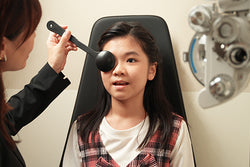
The Silent Thief of Sight
Many eye conditions can develop gradually and may not present symptoms in their early stages. By the time noticeable signs emerge, the damage to your vision can be severe and irreversible. A prime example is glaucoma.
Glaucoma arises when fluid accumulates within the eye, increasing eye pressure which damages the optic nerves at the back of the eyes. This damage leads to a loss of peripheral vision1. What makes glaucoma particularly insidious is its tendency to be hereditary, with an elevated risk among individuals who are myopic (nearsighted)2. Unfortunately, glaucoma remains asymptomatic in its initial stages, leaving many unaware of their condition until it reaches an advanced state.1 Regular, comprehensive eye examinations is the key to detecting glaucoma early3.
Impact of Systemic Health on the Eyes
Systemic conditions such as diabetes and hypertension can affect eye health and lead to vision loss4. These conditions damage the blood vessels in the eyes, resulting in blood and fluid leakage that can cause blurred vision or dark patches at a severe stage4.
Your eye health can reveal information about your systemic health. During a comprehensive eye examination, our skilled optometrists may detect early signs or symptoms that could point to broader systemic health concerns. Since various eye conditions can manifest without obvious symptoms in their initial stages, regular eye check-ups are particularly important, especially for individuals over the age of 405. In this age group, eye exams can serve as early warning systems, allowing for prompt interventions that might mitigate more significant health issues.
Tips to Safeguard Your Vision
Here are some proactive steps to safeguard your vision and maintain healthy eyes as you age:
Shield Your Eyes from UV Damage: Whenever you are outdoors, protect your eyes from harmful UV rays by wearing sunglasses.
Kick the Habit: Avoid unhealthy lifestyle habits like smoking, which can cause early eye degeneration.
Prioritise Overall Health: Managing chronic systemic conditions like diabetes and hypertension is essential for preserving your vision.4
Nourish Your Body: Maintain a balanced diet rich in antioxidants and vitamins, which can positively impact your eye health6.
Schedule Regular Eye Exams: Annual eye exams detect any eye changes early on5, so that any suspicious signs can be investigated and addressed promptly.
The Importance of Regular Eye Exams
Regular eye exams play a critical role in catching eye conditions before they progress to a more advanced stage, potentially preserving your vision and quality of life. Detecting eye conditions early allows for more effective management and treatment7.
Don’t wait until you notice significant changes in your vision or experience discomfort to schedule an eye exam. Take proactive steps to safeguard your eye health by booking a comprehensive eye exam today. Book an appointment here at your nearest store.
1. What Is Glaucoma? Symptoms, Causes, Diagnosis, Treatment. “What Is Glaucoma? Symptoms, Causes, Diagnosis, Treatment.” American Academy of Ophthalmology, 6 Dec. 2022, www.aao.org/eye-health/diseases/what-is-glaucoma
2. Iglesias AI, Ong JS, Khawaja AP, Gharahkhani P, Tedja MS, Verhoeven VJM, Bonnemaijer PWM, Wolfs RCW, Young TL, Jansonius NM, Craig JE, Stambolian D, van Duijn CM, MacGregor S, Klaver CCW; International Glaucoma Genetics Consortium (IGGC) and Consortium for Refractive Error and Myopia (CREAM). Determining Possible Shared Genetic Architecture Between Myopia and Primary Open-Angle Glaucoma. Invest Ophthalmol Vis Sci. 2019 Jul 1;60(8):3142-3149. doi: 10.1167/iovs.18-26231. PMID: 31323684; PMCID: PMC6645704.
3. “Five Common Glaucoma Tests | Glaucoma.org.” Glaucoma.org, 9 Feb. 2022, glaucoma.org/five-common-glaucoma-tests/
4. CDC. “Diabetes and Vision Loss .” Centers for Disease Control and Prevention, 19 Dec. 2022, www.cdc.gov/diabetes/managing/diabetes-vision-loss.html
5. “Eye Exams.” Singapore National Eye Centre, 2019, www.snec.com.sg/eye-exams
6. “Diet and Nutrition.” Aoa.org, 2023, www.aoa.org/healthy-eyes/caring-for-your-eyes/diet-and-nutrition
7. “Blindness and Vision Impairment.” World Health Organization: WHO, 10 Aug. 2023, www.who.int/news-room/fact-sheets/detail/blindness-and-visual-impairment
← Older Post Newer Post →




